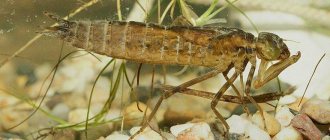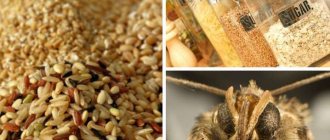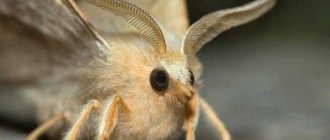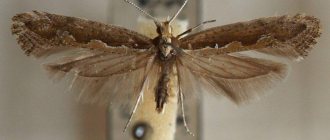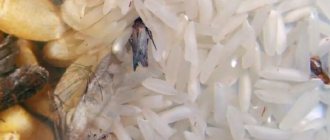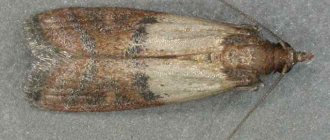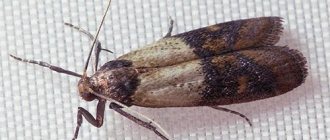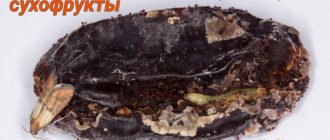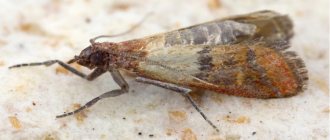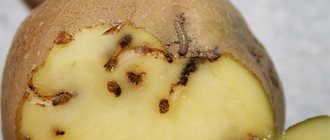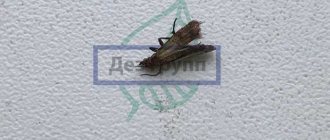The family of true moths is divided into many subspecies. Flying insects with inconspicuous colors can be found in all countries on different continents. Clothes or food moths are more common in apartments. Any type of pest butterfly can cause considerable harm. What moths eat can be determined by the name of the species: fur moth, carpet moth, furniture moth, rye moth, cabbage moth, burdock moth.
A type of moth.
Diet
What does a moth eat? It is worth distinguishing two food groups. The first includes direct food at home. The second includes natural products. The clothes parasite lays eggs in the nests of birds and rodents.
The larvae feed on fur or feathers shed by birds and animals. Under such conditions, their life cycle can significantly increase, since due to the lack of favorable conditions, the parasites have to overwinter in the form of pupae.
In the wild, food moths love nuts and seeds. Usually the parasite finds them in the clutches of forest dwellers.
Insects are more comfortable in the house, since in addition to favorable temperature conditions, there is always cotton or woolen fabric, cereals, nuts, and tea in the home.
Cotton moth
This species is a dangerous agricultural pest. The bollworm destroys cotton plantations in India and China, South America and Australia. Caterpillars damage flowers, buds and green boxes. As a result, these parts of the plant dry out and fall off. If the pest settles in a mature boll, the cotton fiber becomes unsuitable for industrial production.
Close relatives of the cotton moth are the bollworm, soybean moth, corn moth, acacia moth, and cabbage moth.
Representatives of this family can be found in the country house or in the garden. Butterflies lay eggs on rose bushes, corn cobs, and tomato leaves. If pest control is not started on time, the armyworm population can destroy the entire tomato crop or all the buds of a rose bush.
What to eat in the apartment
What do moths eat in a residential apartment? She primarily follows her diet and can eat both clothes and food. It depends on the type of parasite. The food species loves all bulk products, while the clothing species lives on natural fabrics.
There are no strict restrictions in the class, therefore, having destroyed one type of tissue or cereal, the parasite is mistaken for another.
Favorable apartment conditions allow insects to actively develop and reproduce. Therefore, moths strive to get into the living space from the external environment and can even enter through a window.
Life cycle of a moth
What remains is how long the moth lives. Adult fledged individuals have a short lifespan of about 2-4 weeks, this process depends on the type of insect. Such moths fly at dusk because they are not protected from predators. There are two stages that must go through before full puberty occurs.
- The female lays eggs, from which caterpillars emerge within 2 weeks. A prerequisite is a temperature of +20 C.
- Next, the larvae are wrapped in a cocoon, which is created from a special material. The pupa develops in it for a long time, up to 10 months.
Based on the characteristics of this type, it is easy to calculate what the life cycle of a moth is and what damage can be caused to property over its duration.
Stages of moth development photo
What do food moths like in the kitchen?
The food moth feels like a real mistress in the kitchen and quickly infects all the products it likes. The group of these parasites includes granary, grain, and rye moths.
Their diet mainly consists of flour, cereals, and pasta. Some indoor parasites prefer dried fruits, nuts and confectionery.
Insects can be detected by cobwebs in bags, sticky cereals, passages in candy, the presence of dried skins, when larvae or butterflies themselves are detected.
Distinctive features of clothes and furniture moths
Moths destroy clothes in the wardrobe. House and furniture moths are pests that spoil things, wool products, carpet pile and upholstered furniture. Furniture moths prefer lint and fluff, while clothes moths prefer natural threads from which summer dresses are sewn.
But these two types of moths are completely unpretentious in food. They can easily change their food preferences while flying around the apartment. Thus, house moths can gnaw wool fibers, and furniture moths can chew on crepe de Chine.
House moths and furniture moths are similar. Butterflies of both types of moths are small in size, only 5-9 mm with folded wings and a faded dark yellow hue. House moths are much lighter in color than furniture moths, and furniture moths have small dark spots near the beginning of the wings. These differences are so slight that it is almost impossible to see them from a distance.
In the photo: furniture moth and its larvae
Male house and furniture moths fly around the room, while females do not fly at all, although they have wings. In addition, the wings of males are not much larger than the wings of females. Female moths can fly, but they don’t need it. Males fly up to them, mate with them and fly away. Male house moths find their females intuitively. First, the male fertilizes the female, and then after some time the female lays eggs. House moths lay much fewer eggs (about 50) than furniture moths, whose number of eggs can reach several hundred. Females incubate eggs without moving.
In the photo: clothes moth and moth caterpillars
The male house moth is practically no different from the female. How do you differentiate food moths (such as barn moths) from clothes moths? The barn moth has distinct patterns on its wings, while the clothes moth has a single color. House moth larvae can quickly ruin things. But moths are not as big a pest as house moth larvae.
What do clothes moths eat in the apartment?
When it comes to things, moths eat more natural fabrics. Insects of the clothing group include woolen, carpet, fur, clothing, and furniture butterflies.
They feed:
- Wool.
- Knitwear.
- Fur coats, sheepskin coats.
- Knitted items: socks, mittens, hats.
- Fur products.
- Carpeting.
- Upholstery of upholstered furniture.
- Products made from feathers and felt.
Clothes moths prefer woolen products and other products made from natural fabrics, but in the absence of food they can switch to synthetics.
Some parasites have become so adapted to the environment that they attack tissues that contain particles of fallen human epidermis after prolonged wear.
Most insects hide well and it is possible to identify what moths feed on in the house only by examining all the cabinets and potential nesting sites. In one day, the larva can eat a large hole in the owner's favorite thing.
Upon examination, suspicion should be raised by things containing holes, eaten fur hairs, cocoons, passages, skins of parasites, caterpillars.
Interesting. Clothes moth larvae weave a house around themselves from lint and eaten food debris. They use their own saliva to secure the structure. When moving to another place, the larva pulls its house with it, pulling itself up on its front legs.
Why are moths dangerous to humans?
It is believed that this insect does not pose an immediate danger to the human body. The larva cannot bite through the skin: it is too thick for it, and the adult has no oral apparatus at all.
However, in rare cases, allergies to provoking substances occur - chitin or arthropodine, which are contained in scales and hairs on the insect's body.
The disease develops only in cases where a person comes into contact with a large concentration of allergens. Employees of grocery warehouses or woolen products manufacturing plants are at risk of developing a rare type of allergy if there are insect pests there.
Sometimes allergies are triggered by wax moths that live in beehives. From moth larvae, traditional healers prepare remedies in which arthropodine is present in high concentrations.
Cases of an allergic reaction to house moths have not been recorded, since insects do not live in such large numbers in the house.
Moths can cause significant material damage if larvae are found in a wardrobe or kitchen. And this is already a reason for grief, and sometimes nervous breakdown.
What do adults eat?
Having figured out how the larva eats, the question arises of what an individual adult moth eats. Despite the widespread belief that it is harmful, the butterfly is not capable of damaging food and things, since it does not have a developed feeding apparatus.
The most significant damage occurs in egg laying. It turns out that only moth larvae eat, and adult moths contribute to the reproduction of offspring.
Underdevelopment of the proboscis and intestines at the butterfly stage reduces the lifespan of the insect to 15-30 days. An adult moth is able to feed on the reserve fat accumulated during the caterpillar stage, and at the end of it, on its own muscles, thereby shortening its lifespan.
It is because of this that at the end of life the mass of the parasite is 2 times less. If the female carries eggs, then the duration of existence does not exceed 14 days. At the same time, males are able to live up to 1 month.
Major household and agricultural pests
Particular attention should be paid to what the pest moth looks like. There are few of these species, but they can cause significant damage.
Wax moth
Wax moths are a danger to bee hives. The caterpillars of these insects feed on honey and beebread, and also eat bee larvae. In some cases, large colonies can even destroy insulation, which serves as protection for bees from low temperatures.
Interesting fact! The caterpillars of this type of moth are widely used in medicine, since they, feeding on bee products, perfectly digest wax.
Fur moth
When listing the types of moths, it is impossible to ignore the insect that can destroy your favorite fur coat. For this type of insect, your closet, where fur products are stored, becomes a real “paradise”. After all, it is here that she finds an endless source of nutrition.
Fur moth caterpillars carefully trim the fibers using their mouthparts, then crush them and swallow them. After saturation, the larva moves towards its nest and “along the way” cuts off the fur hairs that prevent it from moving freely. That is, these individuals parasitize not only for saturation. As a result, narrow tracks of cut pile are formed on the fur product.
Clothes moth
Clothes moths mainly destroy wool products. External features include the straw color and small size of the insect, which reaches 9 mm with folded wings.
Attention! In addition to items made from natural fabrics, clothes moths can also damage semi-synthetic materials. But with such nutrition, the development process of the caterpillar slows down and it reaches the stage of puberty somewhat later.
Females always move on foot, since, despite the presence of wings, they have no need to fly. During the breeding season, males find them on their own, after which females lay eggs without moving long distances.
Indoor (furniture) moth
The furniture moth is an inconspicuous butterfly of a light yellow hue. Its wings have a characteristic golden tint. Over the course of 15 days, the female lays eggs, the number of which can reach 300 pieces.
While in the caterpillar stage, indoor moths are inactive. They begin to move only after they begin to eat fully. The larvae are very afraid of bright light, and if you put something infected with these pests in the sun, you can see how they begin to hide in folds or crawl into their cocoons.
Important! A decrease in air temperature in the zone of their parasitism can stop the development of caterpillars. They hide in their cocoons and stop parasitizing.
Potato moth
When listing the types of moths, it is worth paying attention to parasites that can cause harm to agricultural land. These individuals include the potato moth. Its appearance is rather unattractive - the wings are a dirty gray color with numerous dark spots.
Fledged individuals have long antennae and live only a few days. When the wings are folded, the body length reaches about 7 mm. The inconspicuous color allows the butterfly to remain invisible even at a short distance when viewed directly.
Attention! The caterpillars die when the temperature drops to +4°C, but having settled directly in the tubers, they can remain alive. As a rule, when cold weather sets in, they move into barns, where they feed on seed potatoes, after which they enter the ground during planting in the spring.
Cabbage moth
Cabbage moth is a pest of cruciferous plants. It has an elongated body and light brown wings. When the wings are folded, the butterfly looks like a small straw. There is a fringe along the edges of the wings of an adult. Like many other species, the cabbage pest flies rather poorly and always remains in close proximity to the place where it emerges from the cocoon.
The caterpillar's head is brown. These insects rarely accumulate in numerous colonies - as a rule, one or two individuals parasitize on one leaf. In the pupal stage, this pest can be found on the stems and leaves of plants, which they feed on.
The eggs of this parasite are easily recognized by their small size and elongated shape. The egg length can reach 0.44 mm, width - 0.26 mm, color - green, which makes them invisible against the background of foliage.
food moth
Food or granary moths can be found in products that were stored in violation of basic rules. Most often these are groceries and cereals. In nature, the source of food for this type of insect is the nuts and fruits of many plants, which causes the parasites to be frequently found in the forest-steppe and steppe zones.
Interesting fact! Food moths are not capable of causing harm to clothing and furniture, since they feed exclusively on cereals, flour, sugar, dried fruits and berries, and can also parasitize in dry pet food.
When the wings of an adult are folded, its body length reaches 8 mm. A moth sitting on any surface is quite difficult to notice at first glance, since it looks more like a small protrusion than an insect.
Caterpillars of this species are light yellow or light pink in color with a smooth body surface. It is impossible to determine the type of barn moth by the appearance of the larvae, but one thing saves you - the fight can be carried out using the same means, so the species is not important.
Normal development of this species occurs under certain conditions:
- air temperature up to +25°C;
- air humidity is about 50%.
The life cycle of a food moth is about one and a half months. This time period includes all stages of insect development.
Danger to humans
Knowing about the ability of moths to damage natural fabrics and food, you should carefully approach the choice of goods when purchasing.
Not all suppliers guarantee the quality of the product; cereals on store shelves may contain parasite larvae, and if the clan penetrates into a home, it will quickly begin to reproduce in favorable temperature conditions.
If you eat affected cereal, then in addition to the larvae in the plate, you can get severe poisoning. The fact is that at the site of parasite production, traces of their vital activity, skins and feces remain.
If the remains are consumed, they can cause intoxication and an allergic reaction in humans.
Therefore, to avoid ending up in a hospital in serious condition after eating cheap cereal, contaminated bags should be disposed of.
Video
food moth
Fighting methods
There is no point in hiding things in plastic bags, since the larvae are able to gnaw passages even in several layers of material in order to penetrate to the food source. They hunt mainly in the dark.
Having understood what moths eat in the apartment and when they eat, you need to choose the right drug to kill them:
- Among home methods, repelling with aromatic herbs is widely used. This does not kill the larvae, but forces adult parasites to look for a new home. The aromas of lavender, wormwood, tansy, rosemary, and geranium are effective. Bunches of herbs are made and hung in the cabinet with the supposed enemy.
- Due to the fear of low and high temperatures, people have a chance to eliminate the problem by steaming and freezing things.
- Moths do not like citrus fruits. Therefore, the crusts laid out in the apartment act as a deterrent, like aromatic herbs.
- If an insect has settled in the kitchen, then it is necessary to carefully sort through all supplies and dispose of contaminated cereals. After this, all cabinets are washed with a solution of vinegar and laundry soap. After disinfection and airing, the remaining products are poured into glass containers and tightly closed with lids.
- When fighting moths, you can use products against cockroaches and other domestic parasites. But since they are quite toxic, it is better to first try to eliminate the problem using more gentle methods. Another means of control are moth traps; they are hung inside the cabinets where the parasite lives.
How to get rid of moths and their larvae?
There are many means that you can use to control pests. Insecticidal preparations are considered the most effective; biological methods and folk recipes show good results.
Chemicals
Chemicals are mainly used to get rid of clothes moths. Not all housewives decide to treat their kitchens with toxic substances. But if there are a lot of insects, then you cannot do without chemicals.
Insecticides are available in the form:
- aerosols;
- emulsions;
- gels;
- plates or liquids for fumigators.
Chemicals must be used carefully, following the instructions and safety precautions.
Biological methods of control
Knowing what moths are afraid of, you can do without harmful chemicals in the fight against them. A safe way is exposure to low or high temperature. Larvae and adults die at temperatures below -10⁰С or above +50⁰С. In order to get rid of pests, clothes can be taken outside in winter, and food can be stored on the balcony or placed in the freezer for several hours. If we talk about heat treatment, then the cereals can be heated in a frying pan or in the oven, and things can be washed at high temperatures or treated with steam.
Use of folk remedies
Many people prefer to use safe and time-tested folk recipes. The most popular of them:
- essential oils (eucalyptus, fir, mint, lemon, grapefruit, clove, lavender);
- vinegar;
- ammonia;
- laundry soap;
- some spices (bay leaf, cloves, allspice);
- dried citrus peels.
All these products are repellents, that is, they repel insects. Soap and vinegar can be used during cleaning; peels, bags of spices and discs soaked in essential oils can be placed in cabinets and on shelves.
